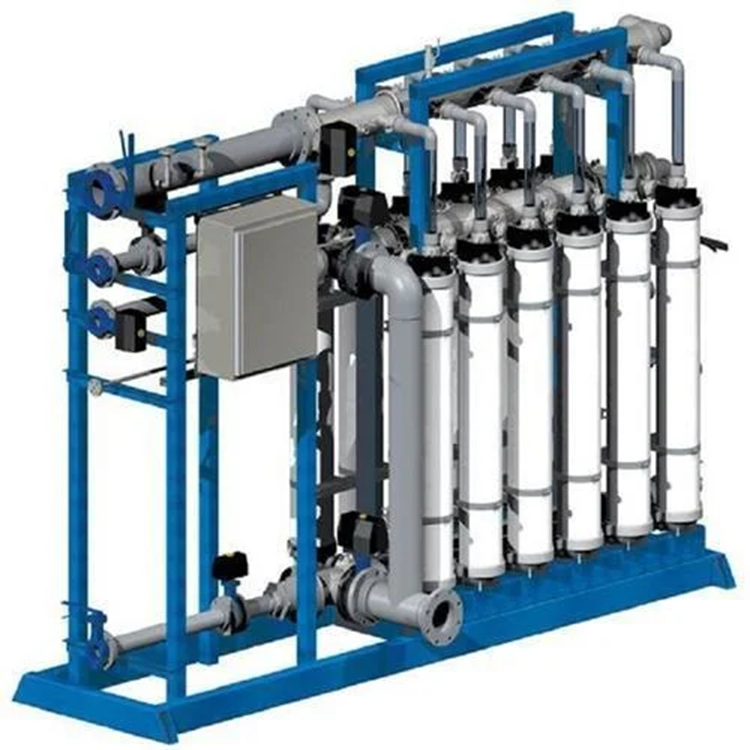Nanofiltration System

Water purification technologies have significantly evolved over the years, with nanofiltration emerging as one of the most efficient methods. A nanofiltration system offers an advanced approach to water treatment, providing high-quality filtration that removes contaminants while preserving essential minerals.
What is a Nanofiltration System?
A nanofiltration system is a pressure-driven membrane filtration process that operates between reverse osmosis (RO) and ultrafiltration (UF). It utilizes semi-permeable membranes with a pore size of approximately 1-10 nanometres, allowing selective removal of contaminants such as dissolved salts, organic compounds, and hardness-causing minerals. Unlike RO, which removes almost all dissolved substances, nanofiltration retains beneficial minerals, making it ideal for drinking water and industrial applications.
How Does a Nanofiltration System Work?
A nanofiltration water treatment system works through the following key steps:
1. Pre-Treatment – Raw water undergoes filtration to remove large, suspended particles and sediments.
2. High-Pressure Pumping – Water is pressurized to force it through the nanofiltration membrane.
3. Membrane Filtration – The semi-permeable membrane selectively removes divalent and larger monovalent ions, organic compounds, and bacteria.
4. Permeate Collection – The purified water (permeate) collected for further use.
5. Concentrate Discharge – The rejected contaminants (concentrate) flushed out to prevent membrane clogging.
Benefits of Nanofiltration Water Treatment
A nanofiltration system offers several advantages over conventional filtration methods:
1. High Contaminant Removal Efficiency – Removes up to 80-90% of dissolved salts, bacteria, viruses, and organic compounds.
2. Selective Filtration – Retains beneficial minerals like calcium and magnesium, making water healthier.
3. Lower Energy Consumption – Requires less pressure compared to reverse osmosis, reducing operational costs.
4. Softens Water – Effectively removes hardness-causing minerals like calcium and magnesium, reducing scale formation.
5. Improves Taste and Odor – Removes chlorine, organic compounds, and other impurities that affect water quality.
6. Versatile Applications – Suitable for both residential and industrial water purification needs.
Applications of Nanofiltration Systems
Nanofiltration water treatment is widely used across various sectors due to its efficiency and cost-effectiveness:
1. Drinking Water Purification
Nanofiltration removes contaminants while preserving essential minerals, making it an excellent choice for producing clean and healthy drinking water.
2. Industrial Water Treatment
Industries require purified water for various processes, including food and beverage production, pharmaceuticals, and chemical manufacturing.
3. Wastewater Recycling
A nanofiltration system used in wastewater treatment to recover and reuse water by removing pollutants and reducing TDS levels.
4. Agricultural Water Treatment
Agriculture benefits from nanofiltration by removing harmful contaminants from irrigation water, improving crop health and yield.
5. Dairy and Food Processing
Nanofiltration is used in dairy processing to concentrate proteins and separate unwanted minerals in milk and cheese production.
Key Considerations Before Choosing a Nanofiltration System
When selecting a nanofiltration water treatment system, consider the following factors:
1. Water Quality Requirements – Determine the level of purification needed based on the application.
2. Flow Rate and Capacity – Choose a system that meets the required water demand.
3. Membrane Type and Material – Select durable membranes suited for specific contaminants.
4. Maintenance Needs – Regular cleaning and membrane replacement ensure long-term efficiency.
5. Energy Consumption – opt for energy-efficient models to reduce operational costs.
Comparison: Nanofiltration vs. Reverse Osmosis
Both nanofiltration and reverse osmosis are advanced filtration methods, but they differ in functionality:
| Feature | Nanofiltration System | Reverse Osmosis |
| Filtration Level | Removes larger salts and organic compounds | Removes almost all dissolved substances |
| Energy Consumption | Lower | Higher |
| Mineral Retention | Retains essential minerals | Removes all minerals |
| Water Waste | Produces less wastewater | Higher wastewater ratio |
| Applications | Drinking water, softening, industrial use | Desalination, ultrapure water needs |
Conclusion
A nanofiltration system is an efficient and cost-effective solution for nanofiltration water treatment in residential, commercial, and industrial applications. It offers selective filtration, energy efficiency, and superior water quality while reducing contaminants. As water treatment technologies continue to evolve, nanofiltration remains a preferred choice for sustainable and reliable water purification.
If you’re looking for a high-performance nanofiltration system, choose one that aligns with your specific water quality needs and efficiency requirements. Investing in nanofiltration ensures safe, clean, and cost-effective water treatment for various applications.
By leveraging the power of nanofiltration water treatment, industries and households can benefit from enhanced water quality while promoting environmental sustainability. For more insights into advanced water purification solutions, stay tuned for our latest updates!
| To use our services right now, you can call us at +91-9812241001 or send us an email at info@kelvinindia.in We will be delighted to assist you! |